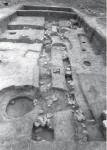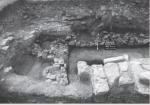Summary (English)
EXPLORATIONS IN PLISKA (Yanko Dimitrov – yanko_aim@mail.bg, Hristina Stoyanova) The timber buildings date to the end of the 8th – first half of the 9th centuries AD. A second trench, parallel to the previously excavated, was discovered at 10 – 20 m from the eastern fortification wall. Similarly to the first one, the newly discovered trench was the foundation of construction of vertical wooden posts that were arranged closely to each other. Sherds of the beginning of the 9th century AD were found in the trench. Both trenches are situated at 5 m from each other and were the foundation of a large timber building. This building is the earliest one among all constructions in the sector, which preceded the fortification wall. Forty-one post holes arranged in five rows were explored. Pottery of the 8th – 9th centuries AD was found. Trenches and postholes from two timber buildings were discovered. These buildings are associated with a layer containing charcoal, iron slag, melting-pots and pottery of the 9th century AD. The stone buildings date to the second half of the 9th – beginning of the 10th centuries. Two walls from the long stone building of the 10 century, which was discovered in 2003, were explored. Two semi-dug sunken-floored houses and 13 midden pits date to the end of the 10th – first half of the 11th centuries. The finds include pottery, a pierced Roman coin of the 3rd century AD, five anonymous Byzantine folles of class A2 (AD 976 – 1030/1035), a histamenon minted by Constantine IX Monomachos (class IVa, 1054 – 1055 emission), glass and bronze bracelets, iron arrowheads, a bronze cross-encolpion and a Byzantine lead seal. A pottery kiln was discovered. The finds include pottery of the 11th century, six anonymous Byzantine folles of class A2, one anonymous follis of class C (1042 – 1050), one anonymous follis of class D (1050 – 1060), a Byzantine lead seal, glass and copper bracelets, a copper buckle, a copper finger-ring, iron arrowheads and iron tools.
- Yanko Dimitrov - Shumen Branch of the Archaeological Institute and Museum
- Hristina Stoyanova - Regional Museum of History – Shumen
Director
Team
Research Body
- Museum in Pliska
- Shumen Branch of the Archaeological Institute and Museum






![Download [PDF]](/excavation/skins/fasti/images/results/download_sml.png)
